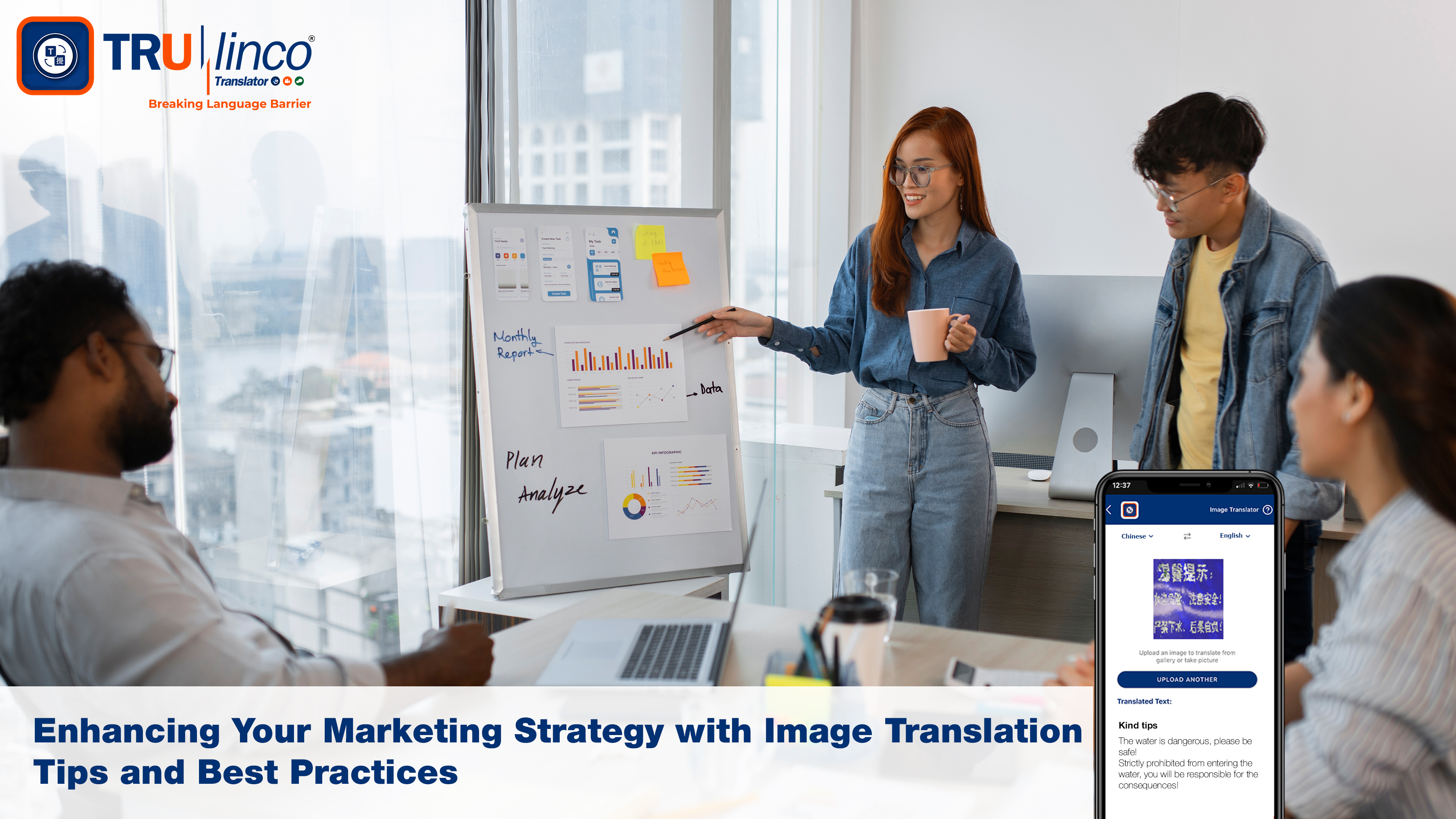
In today’s interconnected world, visuals are the universal language. Images, infographics, and videos transcend spoken tongues, capturing attention and conveying complex ideas with lightning speed. They’re the workhorses of any successful marketing campaign, instantly grabbing the eye and sparking interest in your product or service. But what happens when the vibrant language woven into your marketing visuals becomes a barrier, shutting out a potentially vast audience? Suddenly, the power of the picture is lost in a frustrating sea of confusing text.
Here’s where image translation steps in as your marketing savior. This innovative technology acts as a bridge, effortlessly translating the language within your captivating visuals, allowing them to speak volumes to a global audience. Imagine your product packaging, website banners, or social media posts reaching customers across continents, all conveying the intended message with crystal clarity.
This blog will be your guide to unlocking the transformative power of image translation in your marketing strategy. We’ll explore how it dismantles language barriers, expands your reach to new markets, and ultimately fosters deeper connections with customers worldwide. With a few key tips and best practices under your belt, you’ll be equipped to supercharge your marketing efforts by making visuals truly speak volumes, no matter the language.
How Image Translation Can Enhance Your Marketing Strategy
A. Breaking Down Language Barriers: From Frustration to Fluent Communication
Imagine this: you’ve poured your heart and soul into crafting the perfect marketing campaign, complete with eye-catching visuals that perfectly encapsulate your brand message. But when you launch it internationally, you’re met with a chorus of confusion. Why? Because the text within your images, the key to understanding your product or service, is only decipherable to a limited audience.
Language barriers can be a significant hurdle in the global marketing arena. Traditional marketing campaigns often rely on text-heavy visuals like product packaging instructions or website banners. This approach alienates potential customers who don’t speak the language. Image translation solves this problem by seamlessly translating the text within your existing visuals, ensuring your message resonates with a global audience.
Think about it: a captivating image of a smiling family using your new laundry detergent might not resonate as strongly if the instructions are only in English. By translating the instructions into the local language, you empower potential customers to understand the benefits and make informed purchasing decisions. This not only removes a major barrier to entry but also fosters trust and a positive brand perception.
B. Reaching New Markets, Expanding Brand Awareness: Go Global Without Limits
The world is your oyster with image translation. By removing language barriers from your marketing materials, you unlock the potential to reach entirely new markets. Imagine tapping into a vast customer base in Asia, Europe, or South America, all with the power of a single, well-translated image. This translates (pun intended) into increased brand awareness, a wider customer base, and ultimately, significant growth opportunities.
But it’s not just about reaching new audiences; it’s about connecting with them on a deeper level. Image translation allows you to tailor your marketing materials to local cultures and preferences. For example, humor that lands well in one country might fall flat in another. By translating text within images and considering cultural nuances, you can ensure your message resonates and avoids any unintentional faux pas. This approach fosters trust and loyalty, making your brand more relatable and appealing to a global audience.
C. Improving Customer Experience and Engagement: From Confusion to Clarity
Have you ever struggled to understand the instructions on a product because they were only available in a language you don’t speak? It’s a frustrating experience that can damage customer trust and create a negative brand perception. Image translation eliminates this frustration by ensuring clear communication with your customers, no matter where they are in the world.
Imagine a customer in Japan being unable to understand the assembly instructions for your new furniture due to a language barrier. This could lead to frustration, a negative review, and ultimately, a lost customer. By providing clear and concise translated instructions, you not only improve the customer experience but also demonstrate your commitment to customer satisfaction on a global scale.
This clear communication fosters engagement and builds trust. Customers who can easily understand your product information are more likely to be satisfied and turn into loyal brand advocates. After all, happy customers are the best marketing tool you can have.
Know How to Translate Text from Images? Read More
Tips and Best Practices for Image Translation in Marketing
A. Choosing the Right Image Translation Tool:
With a plethora of image translation tools available, selecting the right one for your needs is crucial. Here are some key factors to consider:
- Accuracy: This is paramount. Look for a tool that utilises advanced AI technology for high-quality translations that accurately reflect the original meaning and intent.
- Supported Languages: Ensure the platform offers translations in the languages relevant to your target markets. The more languages supported, the wider your reach.
- Turnaround Time: Consider whether you require rapid translation for fast-paced campaigns or have more flexibility. Choose a tool that offers options to meet your deadlines.
- Cost: Pricing can vary depending on the features offered. Compare different solutions and find one that fits your budget without compromising quality.
Here at Trulinco, we understand the importance of these factors. Our image translation solution is powered by cutting-edge AI technology, ensuring translations that are accurate, nuanced, and preserve the original message. We support a vast array of languages, allowing you to connect with audiences worldwide. Additionally, we offer flexible turnaround times and competitive pricing to meet your specific needs.
B. Optimising Images for Translation:
A little preparation can go a long way in ensuring a smooth translation process. Here are some tips for optimising your images for translation:
- High-Resolution Files: Use high-quality images with clear resolution. This guarantees optimal translation accuracy.
- Minimal Text Integration: While images can contain some text, avoid overly text-heavy visuals. Opt for simpler designs with less text for easier and more accurate translation.
- Clear Layout: Maintain a clean layout in your images. Avoid overlapping text and graphics, as this can create challenges during the translation process.
- Visual Message Consistency: Remember, the goal is to preserve the overall visual message even with translated text. Consider using universal symbols and avoid culturally specific references that might require adaptation.
C. Integrating Image Translation into Your Workflow:
Image translation doesn’t have to disrupt your existing marketing workflow. Here are some suggestions for seamless integration:
- Batch Uploads: Many image translation tools allow for batch uploads, saving you time and effort.
- APIs: Consider using an API (Application Programming Interface) for automated translation integration into your existing marketing software.
- Project Management Tools: Utilise project management tools to track and manage your image translation projects, ensuring deadlines are met.
By following these tips and best practices, you can leverage the power of image translation and create effective marketing campaigns that resonate with a global audience. Remember, a little planning and the right tools can turn your visuals into powerful communication bridges, driving successful marketing campaigns on a worldwide scale.
Conclusion: Unleash the Power of Visual Storytelling on a Global Stage
In today’s interconnected world, your marketing visuals hold the potential to speak volumes to a global audience. However, language barriers can often mute their message. Image translation bridges this gap, empowering your visuals to resonate with customers worldwide.
By incorporating image translation into your marketing strategy, you can:
- Break down language barriers: Ensure clear communication with your customers, regardless of their location.
- Reach new markets: Expand your brand awareness and tap into exciting growth opportunities.
- Improve customer experience: Foster trust and build loyalty by providing clear and accessible information.
- Enhance brand perception: Showcase your commitment to inclusivity and global engagement.
Trulinco’s cutting-edge image translation solution is here to help you unlock these benefits. Powered by AI technology, we deliver accurate, nuanced translations that preserve the original message and spirit of your visuals. We offer a wide range of supported languages, flexible turnaround times, and competitive pricing to fit your needs.
Are you prepared to advance your marketing approach? To find out more about Trulinco’s image translation services and how we can assist you in overcoming language barriers and establishing connections with audiences around the globe, visit our website. Let your images do the talking, regardless of the language.
Don’t wait – unleash the power of global marketing today!

